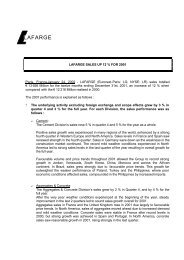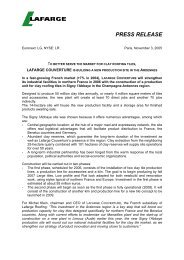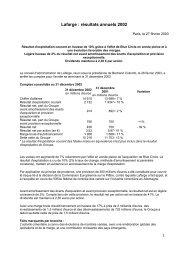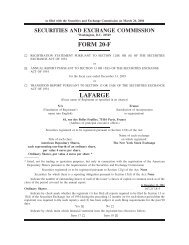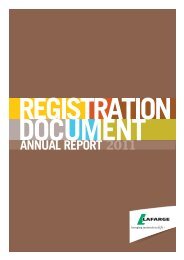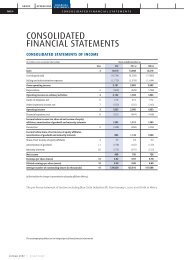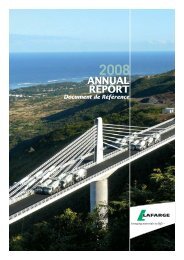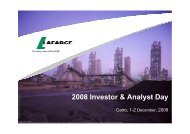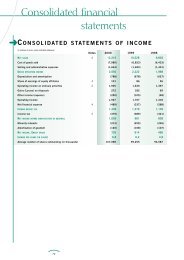2005 Sustainability Report - Lafarge
2005 Sustainability Report - Lafarge
2005 Sustainability Report - Lafarge
You also want an ePaper? Increase the reach of your titles
YUMPU automatically turns print PDFs into web optimized ePapers that Google loves.
AVERAGE TRAINING TIME<br />
PER YEAR<br />
AND PER EMPLOYEE<br />
(in hours) <strong>2005</strong><br />
Managers 42<br />
Non-managers 26<br />
JOB EVOLUTION* <strong>2005</strong><br />
Hirings 7,359<br />
Resignations 3,416<br />
Retirements 776<br />
Redundancies 5,535<br />
Deaths 144<br />
Balance -2,512<br />
* Note: The new acquisitions in China in <strong>2005</strong> are not<br />
included.<br />
ROCK “ORGANIZATION<br />
AND COMPETENCIES”<br />
MODULE<br />
The organization and competencies<br />
of production and maintenance teams<br />
represent one of the pillars of the ROCK<br />
performance program in Aggregates<br />
& Concrete. Through this module,<br />
Business Units organize their operational<br />
planning based on the priorities for their<br />
production performance. Changes in terms<br />
of competencies required are identified<br />
to launch the necessary adaptation plans<br />
without delay. The increase in a quarry's<br />
production volumes and the automation<br />
or introduction of preventative maintenance<br />
provide an opportunity to overhaul<br />
the organization and the competencies<br />
required.<br />
of specialty concretes prompted Business<br />
Unit staff and human resource managers<br />
to define the technical and relational<br />
aptitudes expected of a plant technician<br />
in this new environment. In <strong>2005</strong>,<br />
various units used the profile made<br />
available to them to assess the<br />
competencies of their plant technicians<br />
and to guide training initiatives to<br />
remedy deficiencies between the<br />
required and actual level observed.<br />
In addition, <strong>Lafarge</strong> University continues<br />
to deliver executive training programs,<br />
which were attended by 1,772 people,<br />
i.e. 14.5% of all managers, during <strong>2005</strong>.<br />
Furthermore, specific training sessions<br />
by business, function and country are<br />
also offered to the Group's managers.<br />
Many training programs are available<br />
within the Group, particularly on safety<br />
and in connection with performance<br />
programs. In addition, self-training<br />
softwares are being developed. In<br />
<strong>2005</strong>, the Group’s managers attended<br />
an average of 1.2 training sessions each.<br />
Employee<br />
at <strong>Lafarge</strong> cement<br />
plant in Lichtenburg,<br />
South Africa.<br />
Non-managers attended an average of<br />
0.7 session.<br />
JOB CREATION<br />
AND RESPONSIBLE<br />
MANAGEMENT<br />
WITHIN THE GROUP<br />
In the event of restructuring, <strong>Lafarge</strong>'s<br />
Business Units systematically implement<br />
preventive measures to reduce as far as<br />
possible the impacts on employees and<br />
local communities. A handbook provides<br />
guidance concerning the responsible<br />
management of restructuring, implementing<br />
the principles of our Employment<br />
Policy: performance, anticipation and<br />
solidarity.<br />
In any case, experience is shared through<br />
exchanges with teams that have already<br />
handled this type of process within<br />
the Group. The Banda Aceh plant in<br />
Indonesia provides a perfect illustration<br />
of <strong>Lafarge</strong>'s Principles of Action.<br />
> See pages 38 and 39<br />
LAFARGE | <strong>2005</strong> SUSTAINABILITY REPORT | PAGE 27




